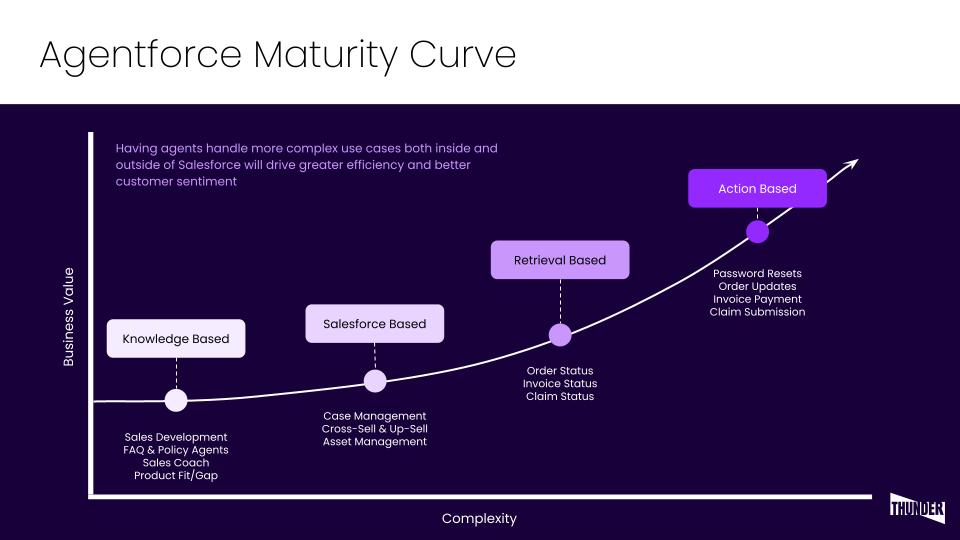BLOG
How to Find Agentforce Use Cases
Written by Dave McCall, VP, Innovation at Thunder
Since Agentforce was announced, businesses are searching for use cases that will deliver true business value. Some companies are hesitant to get started, waiting for reports from the early adopters. Some early adopters are reporting getting less value than they’d hoped. This isn’t because the technology can’t deliver. It is mostly because businesses aren’t going deep enough with their implementations.
Why people aren’t seeing the value out of their Agentforce implementations, yet
Many of the initial deployments are implementing use cases that come “out of the box” with Agentforce. They are default Service Agents that answer questions from their knowledge base and provide case status. Or they are straight-forward Sales development agents that answer questions. These may have limited value. Most of these use cases are slight upgrades to what was available via Einstein bots.
They are however a great first step on a path toward smart, autonomous agents that solve a number of problems and are trusted by your employees and customers. Kudos to the companies who took that first step because they are that much closer to finding significant value from Agentforce.
Where’s the Value?
There are three main business value drivers that most companies anticipate from agents. These are:
- Decreased Costs
From eliminating current or future headcount necessary to handle repetitive and complex tasks that could be automated - Increased Insights
From larger data sets that need summarization and where a human only needs insights - Increased Prospect Conversion or Customer Retention
From offering 24X7 access and/or faster support
Decreasing Costs
If you truly want to get real value, you want use cases that will sharply decrease costs by taking on the work that takes a lot of headcount to handle. To find the right tasks here, you must understand (simplified version):
- How often a task comes up (frequency)
- How long that task takes to complete (time)
- How much it costs for an employee per hour (cost)
So, for potential savings, the value of making that task autonomous using an agent is:
frequency * time * cost = value
For example, let’s assume
- Every day your contact center gets 100 calls per day that are satisfied by a simple query to the knowledge base (frequency)
- Each of those calls takes an average of 6 minutes (0.1 hours) to answer (time)
- Your agents answering that call make $15/h (cost)
100 * 0.1 * 15 = $150/day
Increasing Insights
You have been collecting information, probably more than you’re using. You may collect notes from every sales interaction, case notes for every service inquiry, field notes from every onsite visit, call/chat transcripts, emails, sales activity data, etc. But, who is actually reading all of that data? Your agent can easily look at that data and pull out highlights, build summaries, and look for specific patterns. These can be presented front-and-center to your staff to prepare them for the next call.
This requires you to instruct your agent as to what they are looking for. Your agent isn’t going to just find it.
Increasing Prospect Conversion or Customer Retention
To drive this value, you need to imagine how often a customer might be frustrated or even choose to do business elsewhere when they cannot perform the task in off hours or they simply don’t want to wait for an employee to answer their call, chat, or email. In these cases, you might need to use some imagination.
However, similar rules apply. You need to find use cases where a person can be satisfied by an autonomous agent. The agent needs to provide enough value for it to be worth the “hassle” of even trying.
Understanding the Agentforce Business Value Curve
We have found that the use cases that provide the highest business value are the more complex use cases–those that require your employees to gather a little more information, personalize that information, access multiple data sources, perform multiple tasks, and take actual action.

As the complexity goes up:
- The time it takes for an employee to complete increases
- The level of insights you pull from that data increases
- The amount of happiness the task provides to your customer or prospect increases
Complex use cases drive all three business value drivers.
Why You Shouldn’t Give Up
While more complex use cases are more complex to configure, the one-time cost of configuring an agent to handle them provides repeated value for the long term. Each use case is an investment in future value. So, you should definitely not give up, you should start investing now.
An Agent vs. a Smart Intern
An agent is like a smart intern. This intern takes instructions well, accesses the data that you tell them to access, and is willing to do the work you’ve asked them to do diligently.
An agent is a little better than most human interns because they:
- Are seldom careless
- Won’t ever look at any data that you didn’t tell them specifically to access
- Will follow your instructions every time without embellishing
- Can do some of these things multi-threaded (so they’re doing a task a human could do for let’s say one record or customer at a time for 1,000 or 10,000 at once).
An agent, like a smart intern will sometimes:
- Follow your instructions and that will lead to an incorrect result because your instructions weren’t right
- Provide a bad result because the data to which they have access is incorrect or incomplete
- Get confused and not be able to complete a task
If a smart intern started with your company tomorrow, you might give them a small set of tasks to complete. You should do the same with your agent. You want to give them enough to do that you won’t be embarrassed if you posted them at the digital “front door” of your company.
You might give your agent tasks like the following.
- “When someone asks you for the status of their order, verify that the person is who they say they are (like so) access the order management system (like so) and provide them with the order details (like so)”
- “When someone asks you a question to which you don’t know the answer, search the knowledge base (like so) and if there is an article that seems to answer their question offer them a summary of that article and a link to get more information”
- “Every time an opportunity is updated or an activity is added to that opportunity, go through some specific fields on the opportunity and activities and look for any patterns. Summarize what you find in 50 words or less calling out any time it is indicated that the prospect might have shown signs of being likely to buy or signs that they might not.”
Use Cases that Will Generate Value
So, how do you find the right use cases for your business? It isn’t as hard as it sounds. Answer the following questions:
- What process do people converse with your employees frequently to solve? Or, what insights do you know are locked up in too much data?
- For what process can you provide good instructions to complete?
- For what process is the data accessible to an agent?
Want More Help?
Thunder is here to help. We can help you ideate on use cases that might work. We have a number of example use cases for each type of company that can help you get started. We specialize in diving into business value and providing solutions that help drive to those values.
Contact us if you want to schedule some time to have us help.

Dave McCall
Dave is the VP of Innovation at Thunder. He has worked in CRM consulting for 20+ years and has worked with customers of just about every shape and size. He lives in Chicago's northwest suburbs. He's a libra and likes long walks on the beach.
